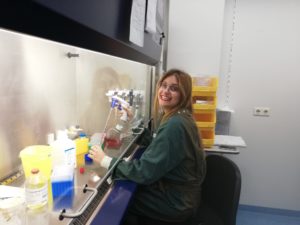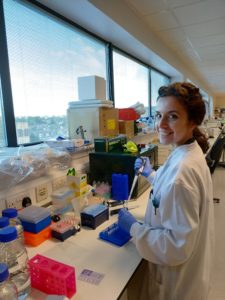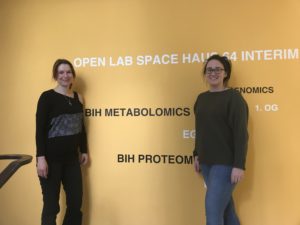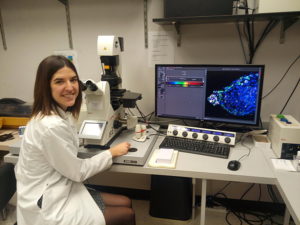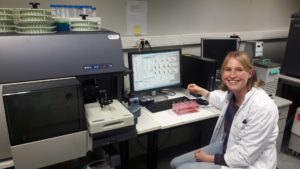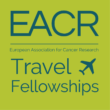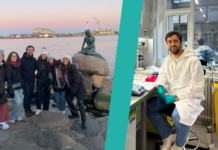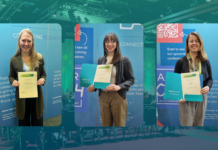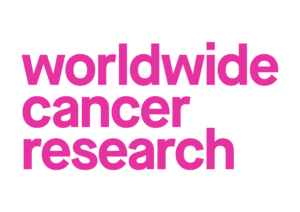 EACR Travel Fellowships are co-sponsored by Worldwide Cancer Research and provide funds up to €3,000 to early-career cancer researchers. For more information on how to apply for Travel Fellowships, you can visit the EACR website.
EACR Travel Fellowships are co-sponsored by Worldwide Cancer Research and provide funds up to €3,000 to early-career cancer researchers. For more information on how to apply for Travel Fellowships, you can visit the EACR website.
Read about the experience of 7 early career EACR members who were able to visit 6 countries thanks to the EACR-Worldwide Cancer Research Travel Fellowships.
1Costanza Maria Cristiani, Postdoctoral Researcher
Home institute: Magna Graecia University of Catanzaro, Catanzaro, Italy
Host institute: Academic Medical Center (AMC), Amsterdam, The Netherlands
Dates of visit: 7 September – 7 December 2019
Research: Our organism is able to eliminate tumor cells thanks to specialized cells known as immune cells. Among them, we possess immune cells able to react against tumors cells in a fast and direct way. My current research focus is to understand the mechanisms by which these immune cells specifically respond to tumors, how these responses can be boosted and if the changes happening on these immune cells can be used to predict the response to different anticancer therapies.
Why did you decide to apply for an EACR Travel Fellowship?
During my Ph.D program, I didn’t have experiences abroad. However, once I started my post-doc, I felt the need to fill this gap. The Head of my Lab talked me about the EACR and the possibility to apply to receive supporting funds. I checked the requirements and, since my profile fitted with them, I decided to apply for the Travel Fellowship.
I’m pretty confident that this research will become a paper that could be published in a high impact journal
How did you choose the host lab?
My research focus has been for a long time on Natural Killer (NK) cells and their role in the context of the tumor immunology. NK cells are members of a wider family of innate lymphocytes known as Innate Lymphoid Cells (ILCs). I thought it could be interesting and useful for my research to extend the focus to all the ILCs members. This was in order to have a better picture on how tumors can affect the innate lymphocyte compartment and vice versa. However, ILCs are very poor ad difficult to identify in peripheral blood. Prof. Hergen Spits is the scientist that firstly identified and characterize ILCs. Hergen and his group are considered as leading experts in the field. Based on these reasons, I chose his lab as host lab, to learn and transfer the best approaches to identify, characterize and manipulate ILCs back to Italy.
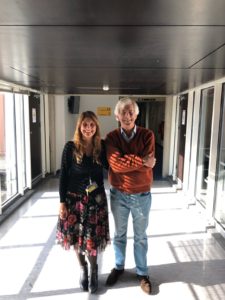
Can you summarise the research you did or what you learned on your visit?
The first part of my research in Hergen’s lab was focused on the deep characterization of peripheral ILCs derived from healthy donors and melanoma patients treated with an anti PD-1 monoclonal antibody (Nivolumab), that is currently used as first line therapy for metastatic melanoma. For an accurate characterization, I used a 14-colors cytofluorimetric approach combining surface markers, cytokines and transcription factors, looking for those subpopulations and markers that could be affected by the disease and/or the therapy. Furthermore, I used a multicolour approach to both sort ILCs and quantify the cytokines they secreted in vitro in response to melanoma cells.
Describe a ‘typical day’ on your visit.
Since I had to perform different kinds of experiments, it’s difficult to define a typical day. However, each week was very well organized. On Thursdays, I picked up a couple of buffycoats to obtain peripheral blood ILC. This meant that the entire day was devoted to peripheral lymphocytes separation and didn’t require cell subsets depletion. The next day, I sorted ILCs and used the obtained cells to start the co-culture with melanoma cells. The co-culture lasted for all the weekend, then I measured the secreted cytokines by cytofluorimetry. Between the coculture experiments, I performed the immune profile of the healthy donors and patients samples obtained from their circulating blood. In these days, I started thawing samples, counting cells and then staining them for surface markers as well as cytoplasmatic molecules. At the end, I acquired them by FACS.
What were you able to do that you could not have achieved in your home lab?
I really think that the theorical and technical skills I gained thave greatly improved my scientific profile
When I left for Hergen’s lab, cytofluorimetry facility in my university was not active. I had neither a 14-colors cytofluorimeter nor a sorter. This meant I couldn’t perform in deep ILCs characterization as well as sort fresh ILCs. In Hergen’s lab I had the possibility to use these techniques and improve my experimental design, learning how to gate this tiny innate lymphocyte population.
Have you brought back any specific knowledge that has benefited your home lab?
Thanks to this abroad experience, I had the possibility to learn how to set a panel for a 14-colors cytofluorimeter as well as a sorter. Since the cytofluorimetry facility of my university is going to reopen this year, I will be able to apply the technical knowledge gained from my experiments on ILCs to other experimental settings also here in Italy.
Does your lab plan to do any future publication with the host lab?
At the present moment, we are working to finalize a common manuscript collecting the data produced in Amsterdam and Italy. Moreover, my mentor Prof Ennio Carbone and Prof Hergen Spits are planning to validate my data in vivo and submit a joint European Union grant application based on the data produced so far. Last but not least, I built very nice relationships with the people working in the lab. I am still in contact with them, so it is possible that in the future I may collaborate again with those who still work in academia.

How has this visit been beneficial to your research and your career?
My previous research focused on a specific ILC subpopulation: NK cells. Thanks to this experience I had the possibility to extend my focus to all the innate lymphocytes that might be involved in melanoma physiopathology, and this is an important boost for my project. I also gained a lot of technical skills I hardly could gain in my home institution.
ILCs are newly discovered cell populations. There is little data about their role in melanoma, particularly in humans. I’m pretty confident that this research will become a paper that could be published in a high impact journal. This will help me to develop my scientific and academic career further.
Thanks to the EACR, I didn’t just have the opportunity to improve my CV but also to work in the laboratory of Hergen Spits, a scientist highly valued by scientific community with a great expertise in immunology. I really think that the theorical and technical skills I gained thave greatly improved my scientific profile. They will also be very useful to develop my future projects.
2Pilar Puerto-Camacho, PhD student
Home institute: Institute of Biomedicine of Seville, Spain
Host institute: Institute of Genetics and Molecular Medicine, Scotland
Length of visit: 90 days
Other funding organisations who supported your trip: EMBO
Research: My current research is focused on the study of the role of a protein called endoglin in Ewing sarcoma. Previously, we have evaluated the pre-clinical potential of endoglin as a therapeutic target in this disease. The appealing results that we obtained leaded us to better understand the role of endoglin from a biological point of view, by deciphering the molecular landscape of endoglin on Ewing sarcoma cells.
Why did you decide to apply for an EACR Travel Fellowship?
I decided to visit the host lab as there were no short-term fellowships available from my university at the time. I felt applying for international fellowships could be a good opportunity. One of my colleagues suggested that I applied for this fellowship, taking advantage of it being specific for cancer research.
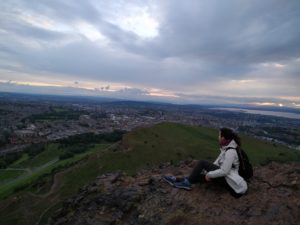
Did you take part in any interesting local/cultural activities?
I was interested in learning as much Scottish culture as possible. I visited several Scottish museums such as the National Museum of Scotland or the Museum of Edinburgh. Furthermore, I became a member of the Scottish National Library. Moreover, I attended some interesting activities such as the Beltane Fire Festival and some guided tours around the city. I visited some fascinating places around Edinburgh such as St. Giles cathedral or the Royal Mary King’s Close, and climbed to the top of the impressive Arthur’s Seat. I adjusted my living habits as a Scottish person would do. For example I would have lunch/dinner at the time they usually do. Or trying traditional Scottish meals and not worrying for the rain at all!
Was there anything you particularly liked about the host institute?
I have learned to open my mind more
The institute’s work dynamic immediately impressed me. Unlike my home institute (IBiS), IGMM assembles all groups working on the same field (i.e. cancer research) in the same area. These groups share the same offices, lab spaces and culture rooms. I consider this is a great advantage as a way of saving space but also favouring communication between people from different groups, which can help enrich your work tremendously.
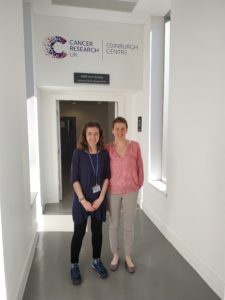
How has the trip inspired you in your research?
As I mentioned, I have matured during this trip. Not only personally but also scientifically. This is thanks to the people from the host lab, who have helped me understand that there can be several ways to answer the same question. I have learned to open my mind more. This trip allowed me to talk with experts in different fields, which was really helpful in enriching my project. This experience would not have been the same without the tremendous support from my colleagues at IGMM. I feel very honoured. I have no words to thank them enough.
How has this visit been beneficial to your research or career?
Regarding my research, I gathered interesting data that will agree with our previous hypothesis, making the conclusion from my Thesis project more robust. Some of the data was completely unexpected, opening new ways of proceeding. Apart from my current research, this trip has enriched my vision regarding the next steps on my scientific career, by allowing me to realise that a postdoctoral position abroad could be a viable option.
I would just thank the EACR once again for the support during this trip. Their help and kind touch has made this experience to be 100% amazing!
3Christina Fleming, PhD Student
Home institute: Cork University Hospital and University College Cork, Ireland
Host institute: Core Metabolomics Facility, Berlin Institute of Health, Max Delbrüch Centre for Molecular Medicine, Berlin, Germany
Dates of visit: 2 – 21 September 2019
Research: Surgery is the most common cure for bowel cancer. Trauma to skin and tissue is required to remove a bowel cancer with surgery. However, we know from previous research that if the ‘surgical trauma or stress response’ is too great it can be associated with early return of cancer usually in the lungs and liver. Such a phenomenon may be observed in as many as 80% of bowel cancer patients who develop return of their cancer following curative surgery. We aimed to characterise if metabolomic differences in blood samples taken from bowel cancer patients before and after their surgery could help us better understand why this occurs and potentially identify future treatments.
Why did you choose the host lab?
Our laboratory interest is mainly to research the perioperative period and identify ways in which we can improve perioperative care to optimise patient outcomes and this was the focus of my PhD thesis. From a scientific viewpoint this has mostly focused on investigation of the surgical stress response (SSR). In particular, how upregulated SSR can lead to increased post-operative complications and even worse cancer outcomes following cancer surgery. To date there is a paucity of research on the metabolome in the perioperative period and how characterising the metabolome may be a useful biomarker or even identify potential therapeutic targets to attenuate SSR.
The core metabolomics facility at BIH is a leading international metabolomic research facility. It has a strong record in publishing new and improved methodology in metabolomics research. BIH has a key focus on the clinical relevance of metabolomic research to patients. It was a very easy choice and I am extremely grateful they agreed to have me visit and for everything that I learned during my time there.
I was really at the frontline of innovative techniques and technologies in metabolomic research
Can you summarise the research you did on your visit or what you learned on your visit?
Extracted and quantified metabolites from three groups of patients undergoing colorectal surgery. Patients were grouped as follows; 1. Patients undergoing surgery for benign colorectal conditions; 2. Patients undergoing surgery for colorectal cancer; 3. Patients undergoing surgery for colorectal cancer who received targeted anti-inflammatory therapy to attenuate their surgical stress response. A Bligh dyer method was undertaken and GC-mass spectrometry was used for metabolite measurement using an online derivatisation method with subsequent metabolite measurement performed using WiPP: Workflow for improved Peak Picking for Gas Chromatography-Mass Spectrometry (GC-MS) data.
Spending time in a scientific setting has enriched my understanding
I learned about extraction technique, mass spectrometry fundamentals, an overview of different bio-informatic methods for data processing and the key quality control methods that are key to any research but particularly to metabolomics. Quality assurance was central to all metabolomic work at BIH. I found the BIH’s research ethos of relentless quality assurance very valuable.
What were you able to do that you could not have achieved in your home lab?
The entire process from metabolite extraction to data processing and analysis at the metabolomics facility BIH is so optimised. It is constantly evolving and improving. As the sole focus of the host lab was metabolomic research I was really at the frontline of innovative techniques and technologies in metabolomic research.
Did you take part in any interesting local/cultural activities?
My favourite way to discover a city is through running. Mapping out different 5, 8 and 10km routes around the city of Berlin allowed me to really experience the melting pot of history and culture. Finished off with a currywurst and local brew of course.
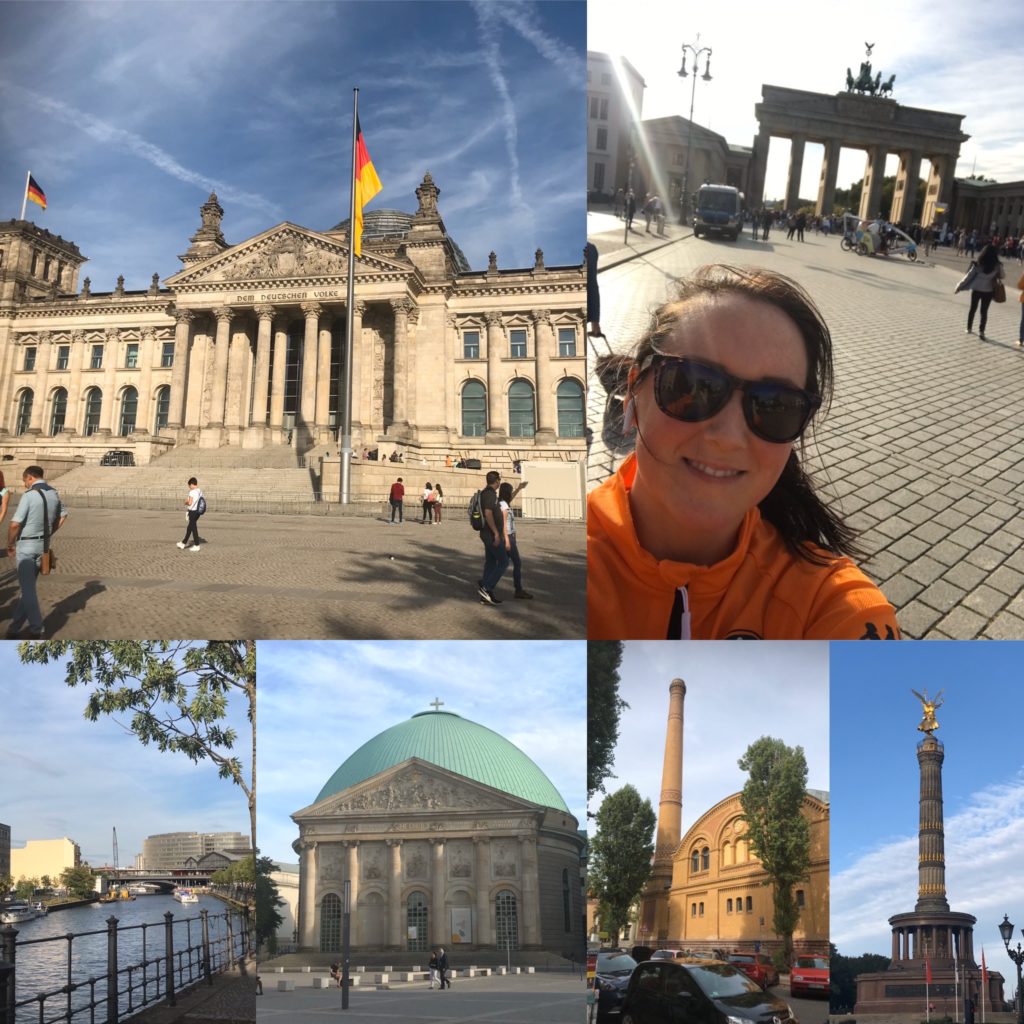
Was the host institution very different from your own?
As a clinician primarily, I always feel completely out of my comfort zone when I initially step foot into a scientific lab compared to my more natural environment of the operating theatre. The metabolomics facility at the BIH however really supported me to build on the laboratory skills I had developed in CUH during my basic science research time and also taught and supervised me to develop new skills working with new techniques.
Did you have a personal mentor or anyone who particularly helped you?
The director Jennifer Kirwan and post-doctoral fellow, Raphaela (Ela) Fritsche, worked with me very closely during my time there. They ensured I was constantly learning and performing my scientific methods to best practice standards. Their knowledge and experience in metabolomic research really fortified the methodology and planned analysis of our work.
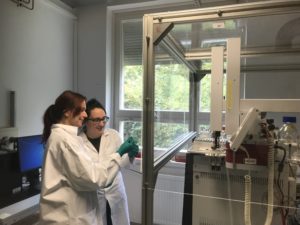
Does your lab plan to do any future collaborations or publications with the host lab?
Now that metabolite extraction and quantification has been performed, we will work very closely with Jennifer and the team over the coming months to continue data processing and analysis. There are further avenues of this research we have discussed exploring also in the medium and longer term.
How has this visit been beneficial to your research and/or your career?
Understanding science and scientific methodology is a critical tool for any medical practitioner. To ensure that patients are receiving the highest standard of care, it is important to practice evidence-based medicine. However it is crucial to understand methodology when interpreting research and to be able to critically assess if the findings are relevant to your patient population and what are the potential limitations in the work you are reviewing. Spending time in a scientific setting has enriched my understanding about scientific methodology. In particular, metabolomics but in other areas also and again the importance of inarguable quality control and quality assurance.
I would just like to sincerely thank everyone at the Metabolomics facility at BIH for welcoming me into their group and supporting me to do my research. In particularly I would like to thank Jennifer Kirwan, Ela Fritsche and Yoann Gloaguen. I look forward to ongoing and future collaborations.
4Deepak Balamurali, PhD student
Home institute: The Azrieli Faculty of Medicine, Bar-Ilan University, Israel
Host institute: EMBL Advanced Training Centre, Heidelberg, Germany
Dates of visit: 23 – 28 September 2019
Research: I work at the Azrieli Faculty of Medicine, Bar-Ilan University, Israel, in the Laboratory of Cancer Genomics and Biocomputing of Complex Diseases under the guidance of Prof. Milana Frenkel-Morgenstern. My research focuses on identifying early diagnostic biomarkers for cancer subtypes and auto-immune disorders, based on non-invasive liquid biopsy approach. To explain my project briefly, we collect blood samples from patients with complex diseases, isolate cfDNA, cfRNA and exosomes and sequence them using Next-Generation sequencing to identify potential hotspots, pathogenic variants or subtle expressional changes. This enables us to design better treatment strategies and aid in the therapeutic stratification of cancers.
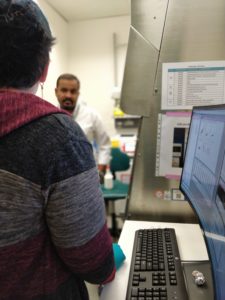
Why did you decide to apply for an EACR Travel Fellowship?
I had been selected for the EMBL Practical course on Liquid Biopsies, held at the EMBL Advanced Training Centre, Heidelberg. I was extremely interested in this workshop as ‘Liquid Biopsies’ course covers almost all the entities that are related to my research work. However, I was unable to obtain a registration or travel fellowship from the organisers. Further, my laboratory was unable to support the costs completely as well.
EMBL courses have become extremely competitive in recent years. Due to their small participant size, only a fraction of applicants are selected (~23% in the case of this Liquid Biopsies practical course). Therefore, I wanted to make the best use of this opportunity that had been provided to me. Thus, I reached out to the EACR to support my candidature by means of a travel grant to attend this practical course at EMBL. I was extremely thankful that EACR was able to help me in this regard.
Why did you choose the course?
I totally am in awe of the state-of-the-art facilities available at EMBL
EMBL Advanced Training Centre was my host for this practical course. They have previously offered this Liquid Biopsies course in 2017 & 2018 and the feedback from the participants was all very positive. The infrastructure available at EMBL, along with the opportunity to interact with speakers/trainers of high calibre were all key motivating factors for me in choosing to attend this practical course at Heidelberg.
Describe a ‘typical day’ on your visit.
The course stretched over six days and almost all the days were hectic – packed with lectures, demo sessions and hands-on training in the laboratory. We would start the day at the ISG Hotel / EMBL Guesthouse where the shuttle bus would pick us up at 8:30 in the morning. Sometimes, our days stretched till as late as 9:15 pm, when we would eventually saunter back to our accommodation. On some days, we even ventured out to walk to EMBL from the Guesthouse – a brisk 15-minute walk at best, which including a small detour through the dense foliage in the region too! The organisers ensured that there was a healthy mix of guest talks, laboratory sessions and some fun activities as well. This enabled the week to fly past at an unbelievably quick rate!
Did you take part in any local or cultural activities?

On the 3rd evening of our course, we were taken on a walking tour of the beautiful Baroque old town of Heidelberg. With the city having rough weather that week (unfortunately for us), most of our tour was under umbrellas and windbreakers. We visited the Church of the Holy Spirit, walked past the Church of the Jesuits, the old tower and bridge across the Neckar, and had our first view of Schloss Heidelberg in all its glory. The following day ended with a course dinner in one of the popular restaurants in the old town, giving us participants and trainers to bond over food and wine.
What was a personal highlight of your trip?
The composition of the course participants was truly global – 16 participants from 15 different countries. The course gave me an opportunity to interact with peers working on similar projects, but in different atmospheres and different stages of completion. It also helped me understand the possible pitfalls / advantages in my project in the future. The course helped me to meet these new people and I look forward to continuing this mutually beneficial exchange of ideas and information with these folks!
How has this visit been beneficial to your research?
My research is based on using the non-invasive Liquid biopsy technique to identify diagnostic/prognostic biomarkers in various complex disorders. This course was extremely useful to me to understand all aspects of this domain of research, starting from the collection strategies to be followed, the numerous techniques for the isolation of different analytes, culminating in their further down-stream processing and data analysis. It was a complete package and was very beneficial to improving my skillset.
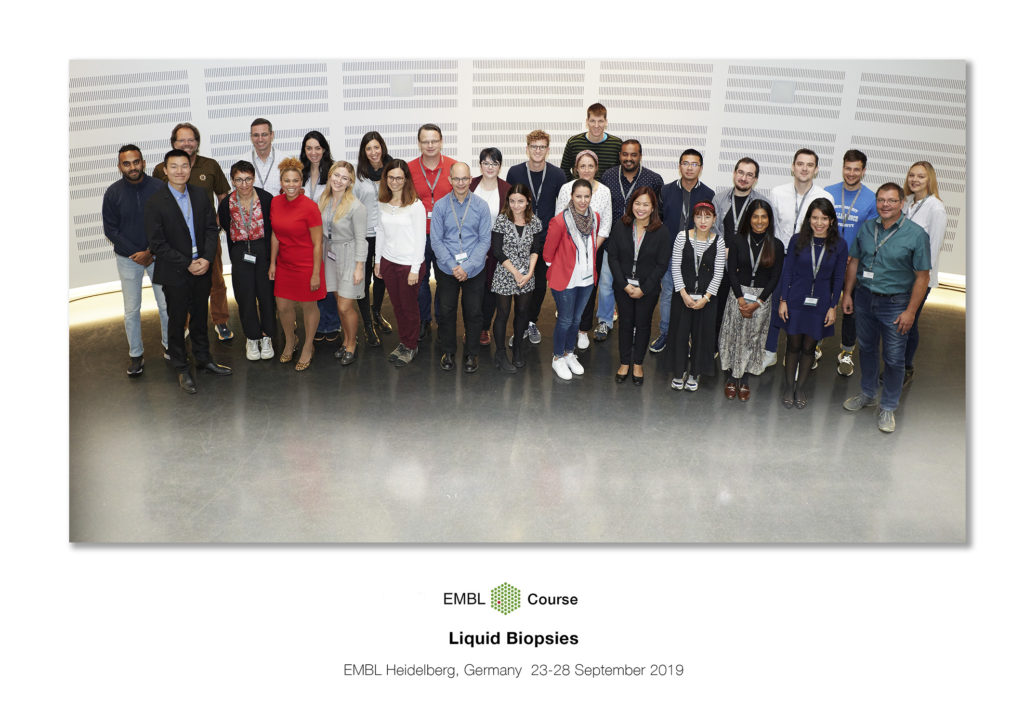
How has the trip inspired you in your research?
The course organisers had lined up an array of highly respected speakers in various fields ranging from biobanking, extracellular vesicles and biomarker detection in cancer to clinicians, pathologists and data analysts. This thorough approach to the workshop has in a way helped me choose which specific part of the process I could be most involved with in my research, while at the same time having an overview of all the subsets of my research
pipeline.
Was there anything you particularly liked about the host institution?
I totally am in awe of the state-of-the-art facilities available at EMBL, and with the multi-cultural atmosphere that prevails in the institution. Six days seemed like too short a stint there definitely and I hope to visit again soon. Perhaps, another application, this time for the EMBL Scientific Visitor Programme is in the offing! *Fingers crossed*
I’m thankful to my research mentor Prof. Milana Frenkel-Morgenstern, for her motivation and support through this ride. Special word of mention for Prof. Anders Stahlberg, Ms. Yvonne Yeboah, Ms. Christina Dollt and Dr. Elisabeth Zielonka for being amazing hosts through the course period.
More importantly, a big thank you to the EACR. Without them, this trip would not have been possible.
5Shannon Nelson, PhD Student
Home institute: Dublin City University, Ireland
Host institute: Aarhus University, Denmark
Dates of visit: 4 June – 31 August 2019
Research: I am studying one of the deadliest cancers – pancreatic cancer. I develop 3D cancer models, called organoids, which are more representative of how the cancer grows in a patient. Using these models, we can study in the lab how small differences in someone’s DNA may make them more likely to develop pancreatic cancer, and how these changes might affect a person’s response to anti-cancer treatment.
Why did you decide to apply for an EACR Travel Fellowship?
I decided to apply for the EACR Travel Fellowship to travel to the Aarhus, Denmark to work with Associate Professor Yonglun (Alun) Luo, and the DREAM (Danish Regenerative Engineering Alliance for Medicine) team to learn the skills and knowledge required to develop a method for the use of CRISPR/Cas9 technology in pancreatic cancer organoids. My supervisor, Assistant Professor Naomi Walsh, encouraged me to apply for this fellowship. It would give me the opportunity to further my research by learning techniques from experts, experience what it is like to work in another lab, and give me the chance to travel and work in another country while completing my PhD. All of these things have helped me to progress my research and will almost definitely improve my future career prospects.
My research trip to Aarhus University has opened many doors for both my research and my career
Can you summarise the research you did or what you learned on your visit?
During my research trip to Aarhus, I was able to advance my limited knowledge of CRISPR/Cas9 gene editing systems. This enabled me to develop gene editing methods using my novel 3D primary cell line systems, termed cell line organoids (CLOs). During my trip, Associate Professor Lin Lin and Trine Petersen (lab technician) trained me. I learned all of the skills required for the production of plasmids, and transduction into the cell lines and organoids. I learned methods that were used to target five transcription factors which we had previously identified. This may play a role in the development of pancreatic cancer.
While in Aarhus, I also had the chance to work on some of the group’s many ongoing projects, including the development of a novel assay for assessing transfection efficiencies. I also had the chance to develop a novel pig aortic endothelial organoid system, which the DREAM team will use going forward for a CRISPR/Cas9 knockout library to further their work in xenotransplantation.
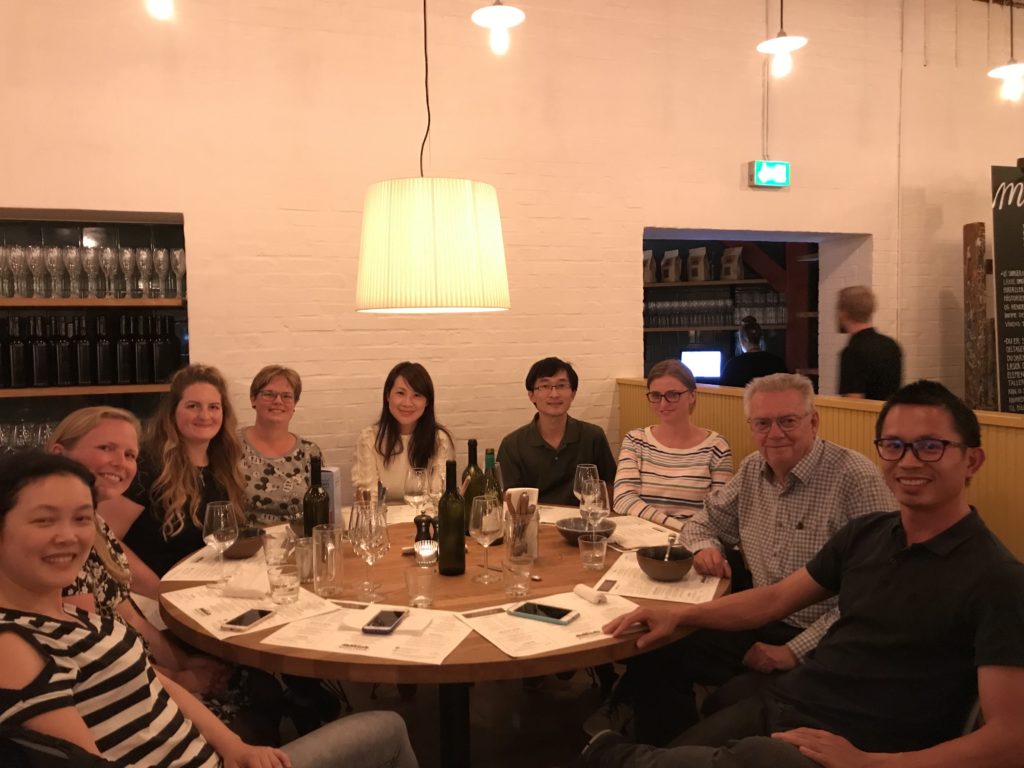
Describe a ‘typical day’ on your visit.
I would start every day with a cycle to the lab, in the newly opened Skou Building at Aarhus University, where the DREAM team is based. During my first week in the lab, some of Lin’s research featured on the front page of Information, a Danish newspaper. The following day, a news team was in the lab and the group was featured in the national news! This wasn’t part of a “typical day”, but it was inspiring and showed me the high-calibre of the research group I had just joined.
Each week, we had group meetings where one of the researchers would present their latest results, and the group would discuss them. Here we had the chance to develop new ideas, and mostly, get inspired by the amazing work that was ongoing in the lab. Lin worked with me in the lab daily to develop the methods that I would use. Plus, Trine was always there to help teach me whatever methods I needed to learn. The best part of working in Denmark during the summer was that the days are so long, so after finishing work, there are still hours of sunshine which always makes finishing a long day easier!
Did you take part in any interesting local or cultural activities?
Surprisingly, scuba-diving is a very popular hobby in Aarhus. I was lucky enough to be able to go diving every Wednesday in the local harbour. Even more surprisingly, there was a lot of plants, crabs, fish, jellyfish and starfish to look at as I swam weightlessly around the harbour. Over the weekends, I also had the chance to go to Lillebælt to do deeper dives and get my advanced scuba diving licence.
I also got the opportunity to do a lot of photography, both underwater and above the surface while exploring Aarhus, and during my weekend trips to other cities like Copenhagen and Aalborg.

Did you have a personal mentor or anyone who particularly helped you?
My EACR travel fellowship would not have been the same without Trine Petersen, a talented laboratory technician. She very took me under her wing, and kindly guided me through every step of my three months in Aarhus. This included training me in the production of plasmids and transduction, helping me to troubleshoot any issues I was having. She was also a great extra set of hands who was willing to help with anything in the lab at a moment’s notice. Trine was incredibly welcoming, and helpful, and I hope that I will get the chance to work with her again soon, either in Dublin or Aarhus.
Does your lab plan to do any future collaborations with the host lab?
Having had the opportunity to work with experts in the CRISPR field, the goal of our groups is to continue the collaboration, and further the skills which I have learned from working in the Luo lab. The ongoing work at Dublin City University is aided by Alun and Lin’s advice. Not to mention regular technical advice from Trine, who is always just a text away! We have already submitted a co-authored paper.
Hopefully the future will hold a trip to the Lars Boland Institute of Regenerative Medicine in Qingdao, China to teach the lab there how to establish, and grow organoids!
How has this visit been beneficial to your research and your career?
My research trip to Aarhus University has opened many doors for both my research and my career. It has allowed me to learn skills about CRISPR/Cas9 genome editing from experts in the field. This is something which I would not have been able to learn in my home lab. It also allowed my research group (the Walsh Lab) to start an ongoing collaboration with the DREAM Team. This will allow me to continue my work, and progress the research I started in Aarhus here in Dublin City University.
I was also invited to speak at the Irish Association of Cancer Research (IACR) Conference in Galway, Ireland in February. There, I had the chance to talk about my experiences applying for the EACR Travel Fellowship, and my time in Aarhus. These opportunities would not have possible if I did not apply for the EACR Travel Fellowship. Hopefully they will make me a more desirable candidate for positions when I finish my PhD.
6Leire Recalde-Percaz, PhD Student
Home institute: Laboratory of Molecular & Translational Oncology, IDIBAPS – University of Barcelona, Spain
Host institute: Aguirre-Ghiso Lab, Department of Haematology & Clinical Oncology, Icahn School of Medicine at Mount Sinai, New York, USA
Dates of visit: 9 February – 17 December 2019
Other funding organisations who supported your trip: Boehringer Ingelheim Fonds travel grant
Research: Metastasis derives from disseminated tumour cells (DTCs) that escape from primary tumours and proliferate in secondary organs. However, metastasis can appear time after diagnosis due to a non-proliferative DTCs phenotype called dormancy. In my project, I study the role of Neuropilin 2 (NRP2) in DTCs biology and metastasis. My results suggest that NRP2 is regulated by proliferative and dormancy-inducer factors in opposite ways. Moreover, I demonstrated that NRP2 blocking promotes a switch from proliferative to dormant phenotype in lung DTCs. Therefore, I propose NRP2 as a dormancy inhibitor factor making it a feasible target protein against DTCs re-awakening and proliferation in secondary organs.
Why did you choose the host lab?
Dr. Aguirre-Ghiso is a pioneer in the study of the molecular mechanisms that regulate the quiescence of DTCs. They use cutting-edge technologies to make important contributions regarding metastatic growth and dormancy. Therefore, I thought that it would be one of the most appropriate laboratories to try to understand the role of NRP2 in DTCs biology and metastasis development.

Did you have a personal mentor or anyone who particularly helped you?
During my first weeks in the laboratory I had the incredible help and support of a second year PhD student in Dr. Aguirre-Ghiso’s lab. She trained me in 3D cultures in vitro using Matrigel as well as in in vitro co-cultures between tumour cells and macrophages. In addition, everybody was ready to help me if needed. This makes my internship much easier since the beginning.
I also have to highlight the support I got from Dr. Aguirre-Ghiso. We met every one or two weeks where we discussed the results as well as we planned new experiments to move forward with the project.
What were you able to do that you could not have achieved in your home lab?
Previously, I studied how growth factors present in the microenvironment regulate NRP2 expression using monolayer 2D assays in vitro. However, the use of 3D cultures in vitro allows greater similarity to real cell behaviour before using in vivo experiments. This means being able to obtain more reproducible and effective results. Therefore, during these 3 months I did a lot of 3D cultures with Matrigel where I cultured and treated tumour cells with TGFβ1 and TGFβ2, demonstrated proliferation and dormancy-inducer factors present in tumour microenvironment (respectively). I analysed whether these factors regulate tumour growth and whether they were able to regulate NRP2 expression.
In addition, I also performed 3D co-cultures with tumour cells and macrophages to study the relation between both cell types and whether macrophages promote tumour growth. In my home laboratory I only worked with single cell type culture but in Dr. Aguirre-Ghiso´s lab I was able to study how different cell types communicate each other. Besides, I was able to block NRP2 expression to study whether NRP2 participates in the cross-talk between tumour cells and macrophages.

Have you brought back any specific knowledge/technique that has benefited your home lab?
As mentioned above, in my home laboratory in Barcelona we work mainly with monolayer 2D assays in vitro. Nevertheless, I find it essential to use models that represent the microenvironment more accurately. This is where cells grow to obtain more representative cellular responses. 3D culture provides more physiologically relevant information and more predictive data for in vivo tests. Therefore, learning how to do 3D cultures in Matrigel has allowed me to be able to understand better how cells respond to different treatments.
In the same way, I also learnt how to perform 3D co-cultures in Matrigel being able to study cell-cell interactions between tumour cells and macrophages, in a more real tumour microenvironment (provided by the Matrigel). In my home laboratory, we had never studied the interaction between tumour cells and macrophages and the role of NRP2 in this interaction. After developing this technique for 3 months, I will be able to study how the cross-talk between both cell types is as well as the effect of NRP2 inhibition (either in tumour cells or in macrophages). In addition, these techniques will also be helpful for my labmates who will be able to adapt them to their research projects.
Describe a ‘typical day’ on your visit.
On a typical lab day, I was usually in the laboratory between 9am and 6pm. After that, I enjoyed the city in all its different ways (walking around, visiting museums…). During my work hours, I was mainly doing bench experiments either cell culture or immunofluorescences. Afterwards, I used the confocal microscopy to be able to take pictures of the performed immunofluorescences. I also took some time analysing the obtained results using different softwares.
Finally, every week we had group meetings where different people from the laboratory presented their working progress. We also had several seminars every week, usually one from the Tisch cancer department and other from the haematology and medical oncology department.
Did you take part in any interesting local/cultural activities?
In my opinion, autumn is the time of the year with the most cultural activities in New York. However, one of the cultural activities I enjoyed most was the Thanksgiving Day, held on the last Thursday of November. It is an important day for American people and they usually spend time with their relatives. They like to prepare big meals with turkey as the main dish. However, as there are a lot of people from outside New York it is usual to do a fake Thanksgiving with your closest friends, named Friendsgiving.
Dr. Aguirre-Ghiso’s lab is quite international with many people from outside New York, so we prepared our own Friendsgiving dinner. Each person prepared a typical dish from his/her country. I enjoyed this a lot and it let me try different dishes from different countries and cultures.
7Fleur Schaper, Postdoc
Home institute: Department of Tumor Immunology, Radboud UMC, The Netherlands
Host institute: Vrije Universiteit Brussels, Belgium
Dates of visit: 1 September – 6 December 2019
Other funding organisations who supported your trip: I also received funding from FEBS
Research: I’m a postdoc in the group of Prof van Spriel in Nijmegen. Our research focusses on how immune cells organize and compartmentalize signaling molecules on their plasma membrane. It is now known that the cell’s plasma membrane is highly dynamic and organized. Tetraspanins are organizers of the plasma membrane. We are studying whether the loss of tetraspanins has an effect on immune cells in the context of cancer.
Why did you choose the host lab?
As a postdoc, it’s important to gain experience in a laboratory abroad. I wanted to learn more about myeloid cells in the tumor microenvironment. Until now, my research mainly focussed on dendritic cells, but there is nothing known about the role of tetraspanins in macrophages and other cells in the tumor. Therefore I chose Prof van Ginderachter’s lab as it is well versed in studying myeloid in the tumor microenvironment context.
Can you summarise the research you did on your visit?
It was a great experience to visit another lab like this
During my visit we focussed on evaluating the role of CD53 (the tetraspanin which is the focus of my research) in several subcutaneous tumor models in mice. We evaluated tumor growth in mice which lacked CD53 and compared these growth curves with wild type littermate mice. Afterwards we would process the tumors, obtaining single cell suspensions. These were subsequently used for multi-colour flow cytometry to investigate the different immune subsets present in the tumor.

Describe a ‘typical day’ on your visit.
The day usually started with some coffee depending on whether we had an experiment or not. When we had a big experiment we would immediately head to the animal facility to start with the experiments where we would measure tumor size. Afterwards we would head down to the lab with tumors from the animals which we would process and subsequently stain with antibodies for flow. I spend also a lot of time behind the flow cytometer, measuring. We also had lunch break together in the restaurant of the university. This was very nice as I would interact with other people from the group as well. If we had an experiment, we usually finished between 6-7pm. On days when I was analysing data I was mostly behind the computer and would leave around 5.
What were you able to do that you could not have achieved in your home lab?
The experiments we performed are not doable by one person. Instead of just one person, there is a whole team who specialize in these experiments. In my home lab this would not be possible as I was the only one in my group working with mice.
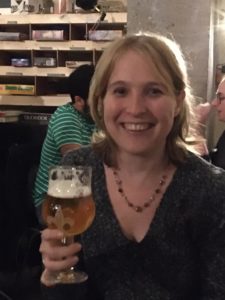
Did you have a personal mentor or anyone who particularly helped you?
When I started, two senior PhD students in the lab were assigned as my mentors. They made me feel very welcome and showed me around the lab. They included in me in their own research, and I collaborated on several experiments with them. Both of them also made sure I was included in all of the different lab socials such as game night or secret Santa. They were always available for questions and helped me out with my experiments and analysing the data.
How has this visit been beneficial to your research and career?
The EACR Travel Fellowship contributed to my further my understanding of myeloid cells. It gave me the opportunity to do some experimental work which otherwise would not have been possible. This has been beneficial for my research. Moreover, personally I has given me the opportunity to gain an international network and experience which will benefit my career. It was a great experience to visit another lab like this.


